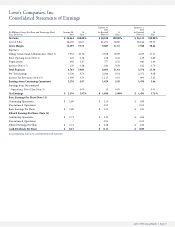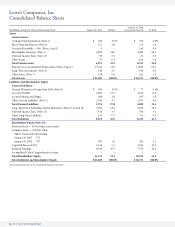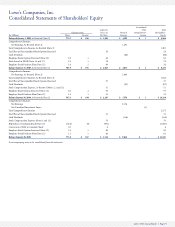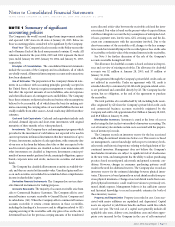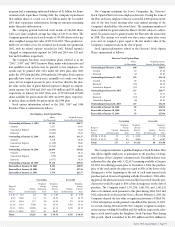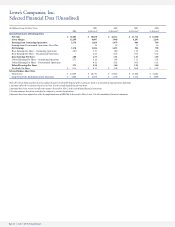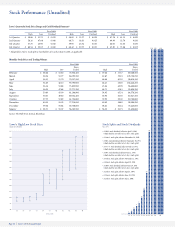Lowe's 2004 Annual Report Download - page 38
Download and view the complete annual report
Please find page 38 of the 2004 Lowe's annual report below. You can navigate through the pages in the report by either clicking on the pages listed below, or by using the keyword search tool below to find specific information within the annual report.
Page 36 Lowe’s 2004 Annual Report
NOTE 4
Investments
The Company’s investment securities are classified as available-for-
sale. The amortized cost, gross unrealized holding gains and losses and
fair values of the investments at January 28, 2005, and January 30,
2004, were as follows:
January 28, 2005
Gross Gross
Type Amortized Unrealized Unrealized Fair
(In Millions) Cost Gains Losses Value
Municipal Obligations $ 162 $ – $ – $ 162
Money Market Preferred Stock 9 – – 9
Classified as Short-Term 171 – – 171
Municipal Obligations 97 – (1) 96
Corporate Notes 19 – – 19
Asset-Backed Obligations 16 – – 16
Mutual Funds 14 1 – 15
Classified as Long-Term 146 1 (1) 146
Total $ 317 $ 1 $ (1) $ 317
January 30, 2004
Gross Gross
Type Amortized Unrealized Unrealized Fair
(In Millions) Cost Gains Losses Value
Municipal Obligations $ 626 $ – $ – $ 626
Money Market Preferred Stock 78 – – 78
Corporate Notes 7 – – 7
Classified as Short-Term 711 – – 711
Municipal Obligations 92 – – 92
Corporate Notes 32 – – 32
Agency Bonds 23 – – 23
Asset-Backed Obligations 16 – – 16
Mutual Funds 5 1 – 6
Classified as Long-Term 168 1 – 169
Total $ 879 $ 1 $ – $ 880
The proceeds from sales of available-for-sale securities were $117
million, $204 million and $2 million for 2004, 2003 and 2002, respec-
tively. Gross realized gains and losses on the sale of available-for-sale
securities were not significant for any of the periods presented. The
municipal obligations classified as long-term at January 28, 2005, will
mature in one to five years. Corporate notes classified as long-term at
January 28, 2005, will mature in one to two years. Asset-backed obli-
gations classified as long-term at January 28, 2005, will mature in two
to seven years.
NOTE 5
Accounts receivable
In May 2004, the Company entered into an agreement with GE to sell
its then-existing portfolio of commercial business accounts receivable
to GE. During the term of the agreement, which ends on December 31,
2009, unless terminated sooner by the parties, GE also purchases at
face value new commercial business accounts receivable originated by
the Company and services these accounts. These receivables arise pri-
marily from sales of goods and services to the Company’s Commercial
Business Customers.
The Company accounts for the transfers as sales of the accounts
receivable. When the Company sells its commercial business accounts
receivable, it retains certain interests in those receivables, including the
funding of a loss reserve and its obligation related to GE’s ongoing
servicing of the receivables sold. Any gain or loss on the sale is deter-
mined based on the previous carrying amounts of the transferred
assets allocated at fair value between the receivables sold and the inter-
ests retained. Fair value is based on the present value of expected
future cash flows taking into account the key assumptions of antici-
pated credit losses, payment rates, late fee rates, GE’s servicing costs
and the discount rate commensurate with the uncertainty involved.
Due to the short-term nature of the receivables sold, changes to the key
assumptions would not materially impact the recorded gain or loss on
the sales of receivables or the fair value of the retained interests in the
receivables.
The initial portfolio of commercial business accounts receivable
sold to GE in May 2004 totaled $147 million. Total commercial busi-
ness accounts receivable sold to GE since program inception through
the end of 2004 totaled $1.2 billion. During 2004, the Company rec-
ognized losses of $34 million on these sales as SG&A expense, which
primarily relate to the fair value of the obligations incurred related to
servicing costs that are remitted to GE monthly. At January 28, 2005,
the fair value of the retained interests was a net liability of $0.2 million
and was determined based on the present value of expected future
cash flows.
NOTE 6
Property and accumulated
depreciation
Property is summarized by major class in the following table:
Estimated Depreciable January 28, January 30,
(In Millions) Lives (In Years) 2005 2004
Cost:
Land N/A $ 4,197 $ 3,635
Buildings 7-40 7,007 5,950
Equipment 3-10 5,405 4,355
Leasehold Improvements* 7-30 1,401 1,133
Total Cost 18,010 15,073
Accumulated Depreciation and Amortization (4,099) (3,254)
Net Property $ 13,911 $ 11,819
* Leasehold improvements are depreciated over the shorter of their estimated useful lives
or the term of the related lease, which is defined to include the non-cancelable lease term
and any option renewal period where failure to exercise such option would result in an
economic penalty in such amount that renewal appears, at the inception of the lease, to
be reasonably assured. During the term of a lease, if a substantial additional investment
is made in a leased location, the Company also reevaluates its definition of lease term to
determine whether the investment would constitute an economic penalty in such
amount that renewal appears, at the time of the reevaluation, to be reasonably assured.
Included in net property are assets under capital lease of $538 mil-
lion, less accumulated depreciation of $227 million, at January 28,
2005, and $539 million, less accumulated depreciation of $201 million,
at January 30, 2004.
NOTE 7
Impairment and store
closing costs
The Company periodically reviews the carrying value of long-lived
assets for potential impairment. When management commits to close
or relocate a store location, or when there are indicators that the car-
rying value of a long-lived asset may not be recoverable, the Company
evaluates the carrying value of the asset in relation to its expected
future cash flows. If the carrying value of the asset is greater than the



